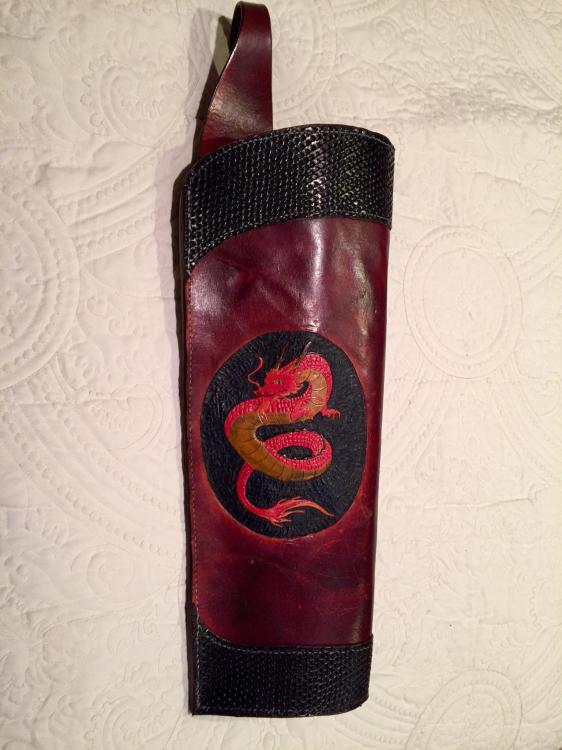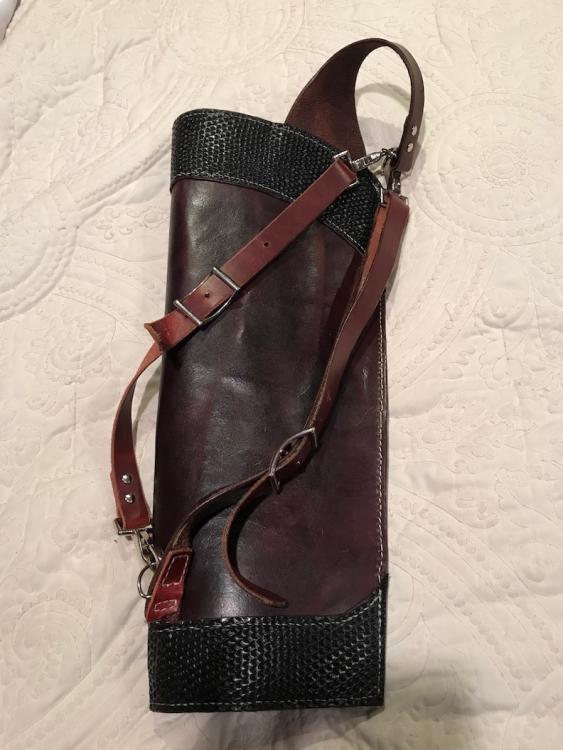-
Posts
6 -
Joined
-
Last visited
Contact Methods
-
Website URL
http://daddomedia.com
Profile Information
-
Gender
Male
-
Location
Crozet, VA
-
Interests
Leather making (of course), archery, karate, photography, wine, cooking
LW Info
-
Leatherwork Specialty
Still learning; no specialty yet
-
How did you find leatherworker.net?
Net surfing
Recent Profile Visitors
1,396 profile views
Capn Cohen's Achievements

New Member (1/4)
-

2016 Projects
Capn Cohen replied to Capn Cohen's topic in Gun Holsters, Rifle Slings and Knife Sheathes
Thanks!- 2 replies
-
- knife sheaths
- kids
-
(and 2 more)
Tagged with:
-
Okay, so it's been about a year since I made these. But I've also been busy at a new job, which tended to monopolize my time. Still, I just wanted to show off the latest from my workshop: two knife sheaths (pouch and Mexican drop loop) and horsey reins (for a friend who owns a preschool). This year (whatever's left of it), I'm getting into a baldric and frog (for holding cutlass for pirate outfit) and a slide-on ammo holder.
- 2 replies
-
- knife sheaths
- kids
-
(and 2 more)
Tagged with:
-
I"m also an archer who started leatherworking a couple years ago. Just like you, I gradually acquired tools as I learned the craft (still learning). I also wanted a nice back quiver but didn't like the prices or designs. First, I visited a lot of websites and archery shops. Then I purchased and downloaded an archery pattern book from Tandy Leather. Finally, I just dove in, adjusting the design as I went. As a one-man communications department for my company, I'm proficient in Photoshop, which, in turn, is extremely handy for manipulating images I'd like to trace and then carve. Is a homemade, leather quiver less expensive than one you could buy? It depends on how you value your time and if you consider the experience a profit in education. I think it is. I've included photos of the one I made. I don't know how far in the process you've gotten, but just a couple pieces of advice: Use no heavier than 9 oz. leather; you want some flexibility to allow the quiver to form to your own back and keep the arrows inside if you bend over or run. Also, keep your quiver wide, not circular, to ease the pullout of arrows. Good luck!
-
Hi, Brett, and welcome. I'm 55 and started messing around with small leather projects about a year ago. Like you, I'm thinking about making some money doing something I enjoy and take pride in. This site is a terrific place to find knowledge and get advice. I'm an archer and karate black belt (Shito Ryu -- traditional style Okinawan te) hoping to perhaps target my projects into those niches. I just made my first back quiver, a kind of graduation from small crafty items to actual leather making. But I don't think I could have done it without this site. Sounds to me that you have a great advantage as a retired vet. You would most likely have a great rapport with fellow vets and active military and could take advantage of web-based networking directly to them. And I bet that many of them share the same interests in firearms, hunting, fishing and other outdoor activities where your products would be useful. Have you thought about making business cards and working the gun shows (not only setting up your own table with your portfolio and samples, but leaving your cards with gun sellers and knife makers/retailers)? Maybe offer a break in price or additional custom work to customers who buy guns and knives from those particular sellers as a package deal)? And don't forget to set up a mobile-viewable website that shows off your work, so the guy that picks up your card at the gun expo can instantly look at your finery. As I get more proficient and confident, I intend to not only post biz cards at archery clubs/ranges, and dojos, but also ads on their web sites. As I learned from catering and photography, you need to sell yourself mostly by word of mouth and personal rapport. Otherwise, most folks tend to shop mainly by price. And you don't want that market segment. Like Dwight said, you can't--and shouldn't--compete with Walmart, Dick's, Cabela's or even Holsters.com, Safariland, Bianchi, etc. On the other hand, you can't price your handmade, custom products out of the market. So you need to do some research as to price points and competition. What you do is an amazing art form, but it's also a business with marketing concerns. Good luck!
-
I'm an archer who just finished his first back quiver. Over 40 hours of labor (maybe closer to 50; I stopped keeping exact tally at 38). It's my own design, an adaptation (mutation?) of a very basic Al Stohlman/Tandy template, which had no carving or overlays. This project was a lot of self-education about tools, cutting, carving, stamping, dyeing (including mixing and shading), leather characteristics, hardware, problem-solving, and finishing. The close-up of the dragon carving was taken before I dyed the rest of the quiver. I got the dragon, by the way, from the web, imported it into Photoshop, manipulated it into a line drawing, scaled and printed it, traced it, then transferred it to the leather. I'm really proud of how it turned out, especially since I don't consider myself much of an artist. The overlays took a total of about 10 hours to cut (had to be a bit wider than the quiver to make up for a little extra circumference, especially over the straps), stamp like dragon scales, dye, and sew by hand (had to do that as I curved the quiver, otherwise they wouldn't lie flat). But they were worth the effort. Of course, I hand-sewed the entire quiver and learned how to keep my diamond awl sharp. The Tandy plans called for a 24" strap from the bottom. After sewing, I realized that this was way too short. So I had to improvise, sewing on an extension in a non-visible way. This was my 6th leather making project ever, though many times more complex than the others (coaster, archery arm guard, change purse, wallet, and uncarved and pre-dyed hip quiver). I really couldn't have made this quiver, however, without the comments I found at this site. Thanks to both the pros and novices who wrote about their experiences.
-
After getting some invaluable advice from these forums, this is my first post. I'm making a back quiver--my first--based on a Stohlman (Tandy) design. I'm adding an overlay at the bottom. The quiver is 7/9 oz, the overlay is 4. The plans call for a plug to be sewn in (smaller diameter heavy leather glued on larger diameter lighter piece. The lighter one is then wetted, formed and folded back; glued and then sewn to the quiver). Even without the overlay, may I assume I need to use a curved (upholstery) needle and use a running stitch? Should/can I get by with just gluing the plug? What's the best way to do all this with the overlay? Thanks for any advice.








